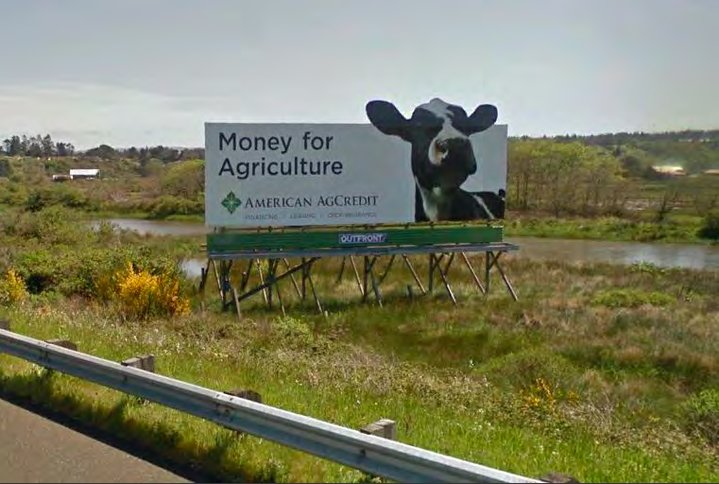
This billboard between King Salmon and Herrick Ave., on the east side of Hwy. 101 just south of Eureka, blew over during a November wind storm. | Photo via county staff report.

How it looks now.
###
PREVIOUSLY: Planning Commission Denies Permit to Rebuild a Fallen Billboard South of Eureka
###
Roughly half of Tuesday’s virtual Board of Supervisors meeting was occupied by a circuitous and sometimes testy deliberation over a fallen billboard.
On the surface, the question was simple. Should Eureka’s AllPoints Sign Company be allowed to rebuild this thing? The advertising plank — some version of which has been in this spot for more than 60 years — blew over during a November wind storm, and AllPoints owner Geoff Wills wants to re-erect it.
Beneath the surface, however, lies a bureaucratic thicket of rules and regulations, raising questions about everything from potential environmental impacts to permit histories, engineering plans, agency jurisdictions and more.
Making the waters even murkier is the fact that in Humboldt County, billboards have become yet another charged cultural issue, with progressives fighting to get them removed from sensitive habitats and scenic vistas while conservatives cite private property rights and the signs’ economic benefits.
Back in May, after a similarly polarized and sometimes confused discussion, the Humboldt County Planning Commission voted 4-2 to deny a special permit that would have allowed the sign to be rebuilt. Wills appealed the decision to the Board of Supervisors, and after debating the matter for close to three hours this afternoon, the board wound up postponing a decision on the matter until its Aug. 18 meeting.
The billboard is considered a legal nonconforming structure, meaning it doesn’t comply with the county’s zoning rules but was grandfathered in because it preexists those rules. One of the fundamental questions, from a permit standpoint, is whether re-erecting the sign constitutes a repair or new construction.
From the beginning of today’s deliberations it was clear that First District Supervisor Rex Bohn thinks the sign should be rebuilt. While the surrounding ground is considered an environmentally sensitive wetland, Bohn said it’s riddled with invasive species and really only gets wet during king tides. He stressed that the sign has been there for decades and sits on Wills’s own property.
It was equally clear from the jump that Third District Supervisor Mike Wilson opposes the sign’s reconstruction. An environmental engineer by trade, he brought up an array of objections to the staff report. He questioned whether the sign was legally constructed in the first place, whether it had been legally maintained, whether it sits within Caltrans’ right-of-way and whether the engineer’s rebuilding plans would have potentially serious environmental impacts.
Adding to the complexity was a revelation from county staff that they’d had a conversation with the engineer just this morning, whereupon they learned that the plans represent a full reconstruction using all new materials. However, Wills insisted that he’d salvage as much of the existing structure as possible, which means that the plans on paper didn’t match the verbal assurances of the applicant.
Wilson pointed to a section of the handwritten plans calling for six “deadman” structures, a term that describes concrete footings — 35 inches three-and-a-half feet in diameter, in this case — holding vertical support beams.
“I’d say that’s an impact that’s been left unanalyzed,” he said. “It seems to me it’s just been glossed over. I think the threshold for fill [allowed] in a wetland is zero. I don’t understand why this is not mentioned in the staff report. It was not mentioned until today.”
Wilson also questioned whether the State Lands Commission has jurisdiction over the sign’s location. Humboldt County Planning and Building Director John Ford said he would research that matter.
Attorney Jeffrey Slack from Eureka firm Janssen Malloy spoke on behalf of Wills and AllPoints. He argued that the Planning Commission’s decision was “an abuse of discretion” founded on inapplicable laws and standards. He also argued that the sign has been there for 60 years without any major issues, and he described AllPoints as a small business that’s employing people during a critical period.
“At a time like this, during a pandemic, it doesn’t make sense to limit economic activity,” Slack said.

Wills. | Screenshot from Tuesday’s meeting.
Wills himself defended the proposal, saying that while he’d originally planned to replace the sign with all-new construction, after talking with staff and seeing the “level of scrutiny” from the public, he decided, “We’ll rebuild it in a manner that has the least amount of impact.”
During the public comment period, Jason Flanders with the Aqua Terra Aeris (ATA) Law Group spoke on behalf of local environmental watchdog group Humboldt Baykeeper, which has long worked toward the removal of billboards in the Humboldt Bay region that sit in coastal wetlands and scenic areas. Flanders argued that the project is not exempt from review under the California Environmental Quality Act and that county staff had not adequately investigated a range of potential impacts.
Environmental advocates including Baykeeper Executive Director Jennifer Kalt and Environmental Protection Information Center (EPIC) Executive Director Tom Wheeler urged the board to uphold the Planning Commission’s decision. A couple of people, including an AllPoints employee, urged the board to overturn that ruling.
The staff report recommended approving the project — both at the Planning Commission meeting and again for today’s meeting. But after the public comment period, Ford reversed course. He said that his conversation with the project’s engineer this morning provided new information that hadn’t previously been considered.
“There could be up to 18 new holes dug that could be up to three feet in diameter within a wetland environment,” he said. “This has not been the context within which this [project] has been assessed.” That being the case, he said, “It would be my recommendation to not approve [the Planning Commission ruling] appeal or the special permit without having that additional information at least.”
The debate continued for some time. Both Second District Supervisor Estelle Fennell and Fourth District Supervisor Virginia Bass expressed sympathy with Wills and concern for his business expenses and, from Fennell especially, his private property rights.
But Bass also said Ford’s warnings gave her pause. “I’m almost feeling like we don’t know enough about how this engineering would work … ,” she said. “It would be nice to have something more ironclad.”
Wills was incredulous, noting that he’d submitted the plans late last year. “How did this come up just now?” he asked. “The plans have not changed since I submitted them.”
Yet more wrinkles: Caltrans has given Wills a 60-day notice to re-erect the sign or lose his permit. And even if the Board of Supervisors approves the project, it still has to get approval from the California Coastal Commission. Pressed on his timeline, Wills said he can request a six-month extension from Caltrans while navigating this red tape.
Bohn made a couple of attempts to thread the needle and salvage an approval from the day’s deliberations. It was clear that a majority of the board leaned in that direction — counting himself, Fennell and Bass — and Bohn suggested approving the special permit with a condition of approval stating that Wills would repurpose as much material as possible from the fallen sign.
But Ford urged caution, noting that as the lead agency, the county is obligated to consider the environmental effects of its actions.
Wilson wound up making a motion to continue the matter to the board’s Aug. 18 meeting, giving county staff time to explore a host of unanswered (or insufficiently answered) questions, including:
- the potential environmental impacts of digging foundation holes
- possible issues pertaining to public trust resources
- potential tribal concerns with those concrete footings, and
- any jurisdictional concerns from the State Lands Agency.
Fifth District Supervisor Steve Madrone seconded the motion, though he went on to encourage Wills to sidestep the entire controversy by withdrawing his application and pursuing a sale of the property to an environmental organization.
Sounding frustrated, Bohn took a couple of verbal jabs at Wilson, telling him, “You found a whole bunch of reasons to get another notch in your belt [and] get another billboard down.”
Madrone took issue with a comment Bass made. Bass, in turn, got a bit defensive and said she’d made the comment in jest. Fennell voiced frustration with county staff for failing to capture all the project’s complexities in their staff report. Everyone seemed a bit grumpy by the end.
An effort was made to schedule a special meeting for Tuesday, Aug. 11, but Madrone said he has plans for that week off, and so the matter fell to Aug. 18. Wilson’s motion passed by a vote of 3-2, with Bohn and Fennell dissenting.
###
A few other matters from today’s meeting:
The board unanimously approved a spending plan for the $13,591,000 in federal CARES Act funding recently dispersed via the state. The plan includes:
- almost $3.3 million for a Small Business Recovery Grant Program, to be dispersed to up to 165 struggling local businesses in $12,000 increments,
- just over $2 million for “local government support,” including costs for employee sick leave, family leave and overtime, plus reimbursement for out-of-pocket expenses on things such as personal protective equipment, telecommuting and sanitization,
- $874,620 for eviction prevention, COVID-19-related homeless shelters, care and food delivery to people in isolation and services for prisoners released early, and
- about $7.4 million for “future needs,” including more overtime and sick leave expenses, testing resources, building renovations, equipment and supplies and contingencies
You can see the full breakdown here.
###
During her regular COVID-19 update, Public Health Officer Dr. Teresa Frankovich said that while “we’re obviously muddling forward with this pandemic across the globe,” she wanted to thank the local community for wearing face coverings and social distancing. “Humboldt is doing pretty well,” she said.
That’s compared to the rest of the state. Humboldt County did pass over a threshold we’d rather not, reaching 30.3 positive cases per 100,000 people over the past 14 days, which is one of two criteria for landing us on the governor’s watchlist. That would mean increased restrictions and the closure of more businesses. Thankfully, our testing positivity rate was just 3.8 percent, as of this morning. The cutoff there is eight percent.
The long-term still looks fairly bleak. Frankovich said increases in case numbers are typically followed by more hospitalizations, more ICU visits and eventually more deaths.
On the good-news front, the county’s Public Health division recently acquired new equipment that will triple its testing capacity.
###
Lastly, local business owner, Rotary Club member and U.S. Army veteran Eddie Morgan was appointed as an alternate on the Citizens’ Advisory Committee on Measure Z Expenditures.
###
NOTE: This post has been updated to clarify Humboldt Baykeeper’s objectives for billboard removal.
CLICK TO MANAGE